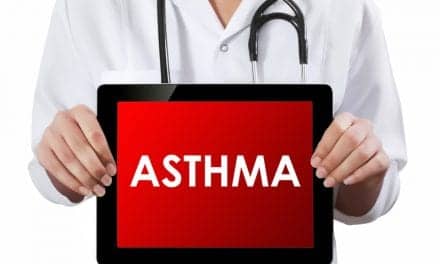Balancing the risk of medication with the benefit to the mother and fetus is crucial in managing patients with asthma who are pregnant.
By Patricia Carroll, RRT, RN, BC, CEN, MS
Care of pregnant women has swung like a pendulum over the past 40 years. In the 1950s and 1960s there were not many concerns about whether pregnant women took medicine, drank alcohol, or smoked cigarettes. The approach then turned to one in which pregnant women were told to avoid all medication except prenatal vitamins; smoking and drinking were absolutely taboo.
Today, research shows clearly the harmful effects of tobacco and alcohol on the fetus. But we also have a body of research showing that rather than forbidding medication—particularly for treatment of chronic illness such as asthma—a better approach is a careful plan that keeps asthma well under control.
The key for any woman who is pregnant or trying to get pregnant is to balance the risk of a medication with the benefit to her and the fetus if she takes it. Hypoxia related to maternal asthma exacerbations is the greatest risk to a fetus, causing significant mortality and morbidity. Proper management of asthma that prevents acute episodes of airway obstruction during pregnancy virtually eliminates risk of fetal hypoxia.
Asthma and the Pregnant Woman
Asthma affects 1% to 9.5% of women or 200,000 to 376,000 pregnancies in the United States every year.1 A study2 coordinated at 16 centers across the United States followed 1,739 pregnant women with asthma from less than 26 weeks’ gestation through delivery and classified the women’s asthma as mild, moderate, or severe based on the National Asthma Education Program guidelines, with adjustments made for daily medication use. Women needing daily medicine generally were classified into a level higher than the one defined by their symptoms and pulmonary function alone.
Researchers learned that the initial classification predicted which women were most likely to experience exacerbations: 12.6% of women classified as mild, 25.7% of women classified as moderate, and 51.9% of women classified as severe had acute symptomatic episodes requiring medical intervention, including hospitalization (which occurred in 89 women). By knowing who is at the most risk, education and monitoring can be targeted to identify changes in lung function as early as possible, optimizing rescue treatment and minimizing the risk of fetal hypoxia.
This large-scale study confirmed previous studies that showed asthma severity can change during pregnancy. In this group, 30% of women initially classified as mild were reclassified as moderate-to-severe during the pregnancy, and 23% changed from moderate-to-severe to mild. The rest were unchanged.
Another study1 of woman in Connecticut and Massachusetts looked at pregnancy outcomes (focused on the baby, not the mother) in relationship to asthma severity and medications taken. Researchers were unable to prove whether the increased risk of preterm delivery identified was related to the asthma diagnosis or to chance. There was an increased likelihood of preterm delivery when women were treated with theophylline alone or in combination with oral corticosteroids,1 and an increased risk for pregnancy-induced hypertension in pregnant women and hyperbilirubinemia in infants of women taking steroids.3 However, treatment with oral corticosteroids does not increase the risk of congenital abnormalities.4
Women whose asthma severity and symptoms increased during pregnancy had a significant decrease in intrauterine fetal growth, likely due to chronic, mild hypoxia.1
A proactive approach in patient management includes discussing the possibility of pregnancy with women with asthma who are of childbearing age, optimizing their lung function, minimizing triggers with non-drug approaches, and achieving optimal lung function with comprehensive education before conception and throughout a pregnancy. This approach, in which a multidisciplinary team of obstetrical experts and pulmonary experts work together, will help achieve optimal outcomes for mother and baby.3,5 This philosophy presents respiratory care professionals with yet another opportunity to expand their practice into consulting with perinatal specialists to work with at-risk women.
| Table 1. Normal Physiological Changes During Pregnancy3,13 |
| • Diaphragm rises in the chest • Anteroposterior diameter increases more toward barrel chest • FRC, RV, and TLC decrease with unchanged VC, FEV1, and PEFR • O2 consumption increases by 20%, maternal metabolic rate increases by 15%, and CO2 production increases • Alveolar ventilation increase of 40% to 50% results in slightly decreased PaCO2 and increased PaO2 with a slight respiratory alkalosis (pH 7.44) being normal • Work of breathing increases |
Drug Pregnancy Labeling
Congenital abnormalities occur in 3% to 5% of all live US births,5 but less than 1% can be attributed to medication administration during pregnancy. No drug company can take the risk of testing drugs in pregnant women—in fact, this is why almost all premarket testing is done in men or postmenopausal women. Thus, information about drug safety during pregnancy comes from animal models or drug registries maintained of women who need to take medication to treat an illness such as asthma during pregnancy. The Organization of Teratology Information Services (OTIS)6 has been amassing a database of asthma drug use during pregnancy. For example, preliminary results suggest that salmeterol is not a major human teratogen.7
Unfortunately, the traditional pregnancy labeling is of little use in clinical practice.8 The current system was established by the Food and Drug Administration (FDA) in 1979, and since 1997, the FDA Pregnancy Labeling Task Force has been examining options to replace the current letter designations of A, B, C, D, and X with more helpful, detailed, narrative descriptions regarding fertility, pregnancy, and breastfeeding. Today, most drugs (66% in the 2002 Physicians’ Desk Reference) fall into category C by default, which states: “No animal studies have been conducted and there are no adequate and well-controlled studies in pregnant women. Risk cannot be ruled out. OR Animal studies have shown an adverse effect and there are no adequate and well-controlled studies in pregnant women.”9,10
Traditional, double-blind, placebo-controlled research is unethical in pregnant women, so we are often left with retrospective case study, anecdotal, and epidemiological reports that do not control variables and isolate a particular drug’s effect on a developing fetus.
Using Asthma Drugs During Pregnancy
The challenge today is reinforcing the critical need for women with asthma to continue taking their control and rescue medicines. There are so many messages telling pregnant women to avoid any medicines that clinicians have to expend extra effort to be sure the woman understands that controlled asthma is much better for the baby than the uncontrolled asthma that can result from stopping all medications. Fortunately, pregnancy provides many opportunities for regular office visits in which these messages can be reinforced. However, in many cultures, the clinician’s advice is at odds with advice from members of the woman’s extended family, so in some cases, home visits in which all family members can be educated may be helpful.
There are two readily accessible sources of guidance for clinicians prescribing for pregnant women: studies published in the literature, and the database compiled by OTIS. A visit to the OTIS Web site6 allows search by state. Other databases are available by subscription and provide summaries of the literature and other pertinent information.
Beta2-agonists, when administered by inhalation, are considered safe. There are limited human data, but no reports of birth defects and no evidence of increased risk compared with a population of healthy pregnant women. No inhaled drug in this category is favored over another; however, terbutaline and metaproterenol have been used for decades without evidence of teratogenicity.5,11
Cromones. Cromolyn sodium has been used safely for a long time, and there is no increased risk associated with its use during pregnancy.5,11
Inhaled corticosteroids (ICS). These drugs revolutionized asthma care when introduced to the general population, and are similarly well suited to asthma management in pregnant women.5 There is no increased risk for this drug category in general, based on a large amount of human data.11 However, there are no human data on which a risk assessment can be made for individual drugs: budesonide, flunisolide, fluticasone, and triamcinolone.11
Systemic corticosteroids. The OTIS database shows that there is no statistically increased risk to using oral methylprednisolone, prednisolone, and prednisone,11 but its focus is on birth defects, not on pregnant women. There is some evidence of increased risk of pregnancy-induced hypertension. Studies show a variety of maternal complications and birth defects, but these are not case-matched studies, nor do they reach statistical significance. The key, as with use of systemic steroids in any asthma patient, is carefully assessing the benefit of using the steroid to get inflammation under control with the risk of adverse effects—in this case, the risk of fetal hypoxia resulting from uncontrolled asthma.
Ipratropium bromide. There are very limited data on use in humans, but so far, no reports of birth defects. However, since there is no clear advantage of ipratropium over beta2-agonists for asthma management, recommendations are to stick with adrenergic bronchodilators. The same recommendation holds for combination preparations that include ipratropium.5,11
Leukotriene modifiers. There are very limited human data on montelukast and zafirlukast since they are relatively new drugs. Animal studies have shown no adverse effects and there are no reports to date of birth defects in babies born to women who took leukotriene modifiers during pregnancy.5,11
Theophylline. While no longer recommended as first or second-line therapy, you may treat some pregnant women with a theophylline preparation. Pregnancy changes theophylline’s pharmacokinetics; thus, blood levels must be carefully monitored. In addition, it readily crosses the placenta, resulting in fetal tachycardia, and irritability, vomiting, and jitteriness in the newborn.5
Summary
Respiratory care professionals must keep two key aspects in mind when caring for pregnant women with asthma. First, the overarching goal is to get asthma under control with aggressive treatment to minimize the risk of maternal or fetal hypoxia; second is overcoming the common belief that pregnant women should not take any medications during pregnancy. RTs are the ideal clinicians to explain the rationale for treatments with pregnant women (and when indicated, with their families) and to monitor their pulmonary status during pregnancy.
RT
Patricia Carroll, RRT, RN, BC, CEN, MS, owns Educational Medical Consultants in Meriden, Conn, and is the healthcare coordinator for Shelter NOW in Meriden.
References
1. Bracken MB, Triche EW, Belanger K, Saftlas A, Beckett WS, Leaderer BP. Asthma symptoms, severity, and drug therapy: a prospective study of effects on 2205 pregnancies. Obstet Gynecol. 2003;102:739-752.
2. Schatz M, Dombrowski MP, Wise R, et al. Asthma morbidity during pregnancy can be predicted by severity classification. J Allergy Clin Immunol. 2003;112(2):283-288.
3. Alexander S, Dodds L, Armson BA. Perinatal outcomes in women with asthma during pregnancy. Obstet Gynecol. 1998;92:435-440.
4. Czeizel A, Rockenbauer M. Population-based case-control study of teratogenic potential of corticosteroids. Teratology. 1997;56:335-340.
5. Liccardi G, Cazzola M, Canonica GW, D’Amato M, D’Amato G, Passalacqua G. General strategy for the management of bronchial asthma in pregnancy. Respir Med. 2003;97:778-789.
6. Organization of Teratology Information Services. Available at: http://www.otispregnancy.org.
7. Jones KL, Johnson DL, Van Maarseveen ND, Chambers CD, Schatz M. Salmeterol use and pregnancy outcome: a prospective multi-center study [abstract]. 2002 part 2;109(1).
8. Uhl K, Kennedy DL, Kweder SL. Information on medication use in pregnancy. Am Fam Physician. 2003;67:2476,2478.
9. Meadows M. Pregnancy and the drug dilemma. FDA Consumer Magazine, May-June 2001. Available at: http://www.fda.gov/fdac/features/2001/301_preg.html.
10. Doering PL, Boothby LA, Cheok M. Review of pregnancy labeling of prescription drugs: is the current system adequate to inform of risks? Am J Obstet Gynecol. 2002;187:333-339.
11. Robinson LK, Cook B, Gangell S. Compiled data from the Pregnancy Risk Network of Ferre Institute, Buffalo, NY. 2003.










